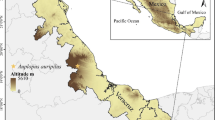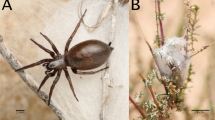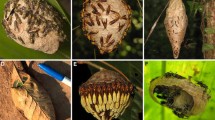Summary
Bolas spiders are relatively rare members of the large family known as orb weavers. Instead of using a typical web to capture prey, late-stadia and adult female bolas spiders swing a droplet of adhesive on a thread at flying insects. Mastophora hutchinsoni (Araneae: Araneidae) is one of five Mastophora species known from the United States and occurs over much of eastern North America. It is univoltine in Kentucky and overwinters in the egg stage. Spiderling emerged in May, the diminutive males matured in late June and early July, and females matured in early September. Eggs were produced from late September to late October or early November. This report is the first complete documentation of the population phenology of any bolas spider. Newly-emerged M. hutchinsoni spiderlings did not use a bolas, but instead hunted by positioning themselves on the underside of leaf margins where they ambushed small arthropods that crawled along the leaf margins. Subadult and adult female M. hutchinsoni used a bolas to capture moths. Only male moths were captured, specifically three species of Noctuidae (bristly cutworm, bronzed cutworm, and smoky tetanolita) and one species of Pyralidae (bluegrass webworm). Among 492 prey captured by more than twenty spiders at two sites during 1985 and 1986, smoky tetanolita moths and bristly cutworm moths accounted for 93% of the total. The flight behavior of approaching moths, the limited taxa caught from a large available moth fauna, and the fact that only males were caught support the hypothesis that the spider attracts its prey by producing chemicals which mimic the sex pheromones of these moth species. Adult female M. hutchinsoni frequently captured more than one moth species on a given night. The two most common prey species were active at different times of night, the bristly cutworm soon after nightfall and the smoky tetanolita generally between 11:00 p.m. and dawn. This pattern suggests that mating activity of these moth species may be temporally isolated, a common phenomenon when sympatric species have similar pheromones. If so, the spider could capture both species without producing different pheromone-mimicking compounds, simply by hunting during the activity period of each species.
Similar content being viewed by others
References
Akerman C (1923) A comparison of the habits of a South African spider, Cladomelea, with those of an Australian, Dichrostichus. Ann Natal Mus 5:83–88
Banerjee AC, Decker GC (1966) Studies on sod webworms. I. Emergence rhythm, mating, and oviposition behavior under natural conditions. J Econ Entomol 59:1237–1244
Bollinger JF, Shorey HH, Gaston LK (1977) Effect of several temperature regimes on the development and timing of responsiveness of males of Trichoplusia ni to the female sex pheromone. Environ Entomol 6:311–314
Carde RT, Comeau A, Baker TC, Roelofs WL (1975) Moth mating periodicity: Temperature regulates the circadian gate. Experientia 31:46–48
Covell CV Jr (1984) A field guide to the moths of eastern North America. Houghton Mifflin Co., Boston, pp 496
Eberhard WG (1977) Aggressive chemical mimicry by a bolas spider. Science 198:1173–1175
Eberhard WG (1980) The natural history and behavior of the bolas spider Mastophora dizzydeani Sp. N. Psyche 87:143–169
Gertsch WE (1947) Spiders that lasso their prey. Nat Hist 56(4):152–158, 189
Gertsch W (1955) The North American bolas spiders of the genera Mastophora and Agatostichus. Bull Am Mus Nat Hist 106:221–254
Haynes KF, Birch MC (1986) Temporal reproductive isolation between two species of plume moths. Ann Entomol Soc Am 79:210–215
Hutchinson CE (1903) A bolas-throwing spider. Sci Am 89(10):172
Jewett HH (1939) Control of sod webworms in lawns. Ky Agric Exp Sta Bull 391:89–106
Longman H (1922) The magnificent spider: Dicrostichus magnificus. Notes on cocoon spinning and method of catching prey. Proc R Soc Queensland 33:91–98
Saario CA, Shorey HH, Gaston LK (1970) Sex pheromones of noctuid moths. XIX. Effect of environmental and seasonal factors on captures of males of Trichoplusia ni in pheromonebaited traps. Ann Entomol Soc Am 63:667–672
Steck W, Underhill EW, Chisholm MD (1982) Structure-activity relationships in sex attractants for North American noctuid moths. J Chem Ecol 8:731–754
Stowe MK, Tumlinson JH, Heath RR (1987) Chemical mimicry: Bolas spiders emit components of moth prey species sex pheromones. Science 236:964–967
Underhill EW, Chisholm MD, Steck W (1977) Olefinic aldehydes as constituents of sex attractants for noctuid moths. Environ Entomol 6:333–337
Author information
Authors and Affiliations
Additional information
The investigation reported in this paper (No. 87-7-76) is in connection with a project of the Kentucky Agricultural Experiment Station and is published with the approval of the Director
Rights and permissions
About this article
Cite this article
Yeargan, K.V. Ecology of a bolas spider, Mastophora hutchinsoni: phenology, hunting tactics, and evidence for aggressive chemical mimicry. Oecologia 74, 524–530 (1988). https://doi.org/10.1007/BF00380049
Received:
Issue Date:
DOI: https://doi.org/10.1007/BF00380049




